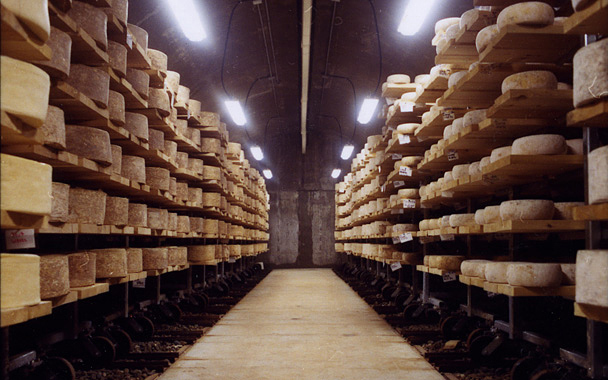Folks in Vermont are making cheese for all kinds of reasons,” says Mateo Kehler. Dressed in a disposable hairnet and barn-worn work boots, he leans forward in a metal lawn chair outside his Greensboro, Vermont, home and delivers the punch line: “Sometimes, they even do it for money.” Kehler and his brother Andy spent $3 million to make an enormous cheese cave, which they blasted into the side of a hill on Jasper Hill Farm, their 260-acre spread. And if Kehler has his way, this state-of-the-art facility will soon be full to capacity with 2 million pounds of high-end cheeses ripening to $25-per-pound perfection; the ranks of Vermont’s profit-driven artisanal cheesemakers will swell; and, ideally, this gorgeous but sad landscape of family farms in terminal decline will transform into a prosperous horizon. If Kehler has his way, his farm will usher in a new age in the making, marketing, and selling of cheese in this country.
Although unique to American cheese production, Kehler’s idea is not unproven: It’s based on a European model, whereby multiple farmstead cheesemakers use a single facility. “The main intent is to lower the barrier of entry to new producers,” says Kehler, who lives with his wife and two young children in an apartment directly above the Jasper Hill cheese room. “They won’t need to invest in the infrastructure and labor, and they won’t have to build the marketing and sales components. These things don’t replicate readily, and the average Farmer Brown just can’t afford to take the risks.”
In both scale and scope, the Jasper Hill cave is astonishing. It comprises 22,000 square feet, divided into seven arched vaults that extend like fingers from a curved atrium. Each vault is climate-controlled with the utmost precision, from 39 degrees and 95 percent humidity for soft, mold-ripened offerings to the relative balm of the 55 degrees and 85 percent humidity demanded by hard cheeses.
The time and expense that Kehler has put into Jasper Hill only reinforce his economic pitch: Commodity milk currently wholesales for about $16 per hundredweight (a gallon of milk weighs slightly more than eight pounds). It takes ten pounds of milk—$1.60’s worth—to make a single pound of cheese, which commands between $3 and $14 on the wholesale market. “We’re trying to articulate something beyond cheese,” says Kehler. “We’re really in the business of economic farm viability.” For the time being, the farm’s own economic viability rides largely on the broad backs of the 40-strong herd of Ayrshire cows that produce the milk and cream for a trio of raw-milk cheeses marketed under the Jasper Hill name: a cloth-wrapped Cheddar called Aspenhurst, a blue known as Bayley Hazen Blue, and a mold-ripened beauty named Constant Bliss. The cave holds cheese from a handful of other producers, but Kehler acknowledges that, while interest has been overwhelming, persuading small dairies to convert their product to cheese has been more challenging than he expected.
So the Kehlers are going to make it even easier for them. Next summer, Jasper Hill will become a core tenant of the newly constructed Vermont Food Venture Center, in nearby Hardwick. The VFVC, which currently operates out of an aging building in Fairfax, is a shared-use kitchen and packaging facility that allows food producers to expand their lines. The Kehlers will use the VFVC’s relocation as an opportunity to perfect both a product and a process that can then be used in small dairies, providing the farmer with a low-risk, turnkey cheesemaking operation that doesn’t require a great outlay of additional money. Ultimately, Kehler envisions a network of regional farmstead cheese producers, with Jasper Hill serving as den mother.



 Pinterest
Pinterest


